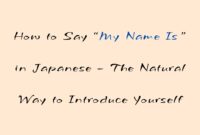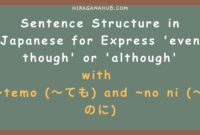Describing an Object in Japanese
Learning to describe objects is a crucial step in mastering the Japanese
language. By understanding basic sentence structures, you can effectively
describe everyday items with ease.
Basic Sentence Structure
The sentence pattern we will explore is:
Noun 1 + は (wa) + Adjective (な/い) + Noun 2 です (desu)
This structure allows you to say things like “That table is big” or “This book
is interesting.”

Example Sentences with な Adjectives
Here are three example sentences using な adjectives:
- けんさんはハンサムなアーティストです (Ken-san wa hansamu na āthisuto desu): Ken-san is a handsome artist.
- たろうさんはまじめなひとです (Tarou-san wa majime na hito desu): Taro is a serious person.
- とうきょうはにぎやかなまちです (Tōkyō wa nigiyaka na machi desu): Tokyo is a lively city.
- おじいさんはしんせつなひとです (Ojiisan wa shinsetsu na hito desu): Grandpa is a kind person.
Example Sentences with い Adjectives
Here are three example sentences using い adjectives:
- フェラーリはたかいくるまです (Ferari wa takai kuruma desu): Ferrari is an expensive car.
- さくらはうつくしいはなです (Sakura wa utsukushii hana desu): Sakura is a beautiful flower.
- しんかんせんははやいでんしゃです (Shinkansen wa hayai densha desu): Shinkansen is a fast train.
- とらはつよいどうぶつです (Tora wa tsuyoi dōbutsu desu): A tiger is a strong animal.
Vocabulary List
To enhance your understanding, here is a list of vocabulary used in the
example sentences above:
-な (Na-Adjectives)
| Hiragana | Romaji | Meaning (English) |
|---|---|---|
| ハンサム | hansamu | handsome |
| まじめ | majime | serious, earnest |
| にぎやか | nigiyaka | lively |
| しんせつ | shinsetsu | kind |
-い (I-Adjectives)
| Hiragana | Romaji | Meaning (English) |
|---|---|---|
| たかい | takai | expensive |
| うつくしい | utsukushii | beautiful |
| はやい | hayai | fast |
| つよい | tsuyoi | strong |
Tips for Learning to Describe Objects
-
Vary Your Vocabulary: Try using different adjectives to
describe the same object to keep your learning engaging. -
Practice Consistently: Regular practice helps reinforce
sentence patterns and vocabulary retention. -
Use Visual Aids: Drawing or looking at pictures of objects
while describing them can strengthen your understanding.
Describing objects in Japanese using the sentence pattern
Noun 1 + は + Adjective (な/い) + Noun 2 です is an essential
foundational step. By practicing example sentences and expanding your
vocabulary, your ability to describe items will improve. Keep practicing and
feel free to use a variety of adjectives to make your communication more
vibrant and interesting.
Happy learning and best of luck on your journey to mastering Japanese!


